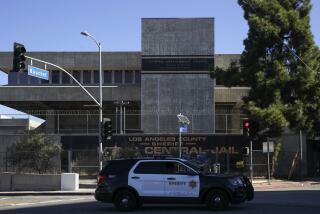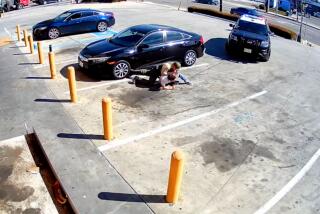Deputies Not Threatened With Knife, Officials Say : Slaying: Sheriff’s homicide reports indicate Ladera Heights man killed by officers never tried to use weapon.
- Share via
Los Angeles County sheriff’s officials said Friday that a mentally disturbed man never threatened two deputies with a knife before they shot him nine times during a confrontation last month in Ladera Heights.
Although Keith Hamilton was carrying a buck knife in a sheath hanging from the front of his waistband, Lt. Jeff Springs, a sheriff’s spokesman, said the 33-year-old former mental patient never reached for the weapon, drew it from the sheath or waved it at the deputies as they attempted to restrain him in his mother’s back yard.
“He never threatened anybody with the knife,” Springs said. “That is not borne out by any of our homicide reports, nor is it consistent with the information we are putting out.”
The lieutenant also said that the sheriff’s investigative homicide file into the shooting has been sent to the district attorney’s office for a determination on whether Deputies Kelly Enos and Paul McCready should face criminal charges in the Aug. 13 incident.
Springs said that Enos, 26, a three-year Sheriff’s Department veteran, and McCready, 27, a four-year veteran, have been relieved of duty with pay. He said they have been forced to turn in their guns and badges and are precluded from performing any law enforcement duties.
Sandi Gibbons, a spokeswoman for Dist. Atty. Ira Reiner, said prosecutors are now reviewing the sheriff’s homicide file, as well as conducting a series of interviews of their own into the late-night shooting in Ladera Heights. She declined to comment on the status of the district attorney’s investigation or to speculate on when the review will be completed.
The incident was one of four fatal shootings in recent weeks that have ignited a public furor over contentions of brutality and racism among sheriff’s deputies.
In an attempt to allay those concerns, Sheriff Sherman Block has created a special citizens panel to review the policies and procedures of his department, and the county Board of Supervisors has requested that the new committee “take on as its first order of business a thorough investigation of the Keith Hamilton incident.”
Sheriff’s officials said Block’s schedule on Friday was clogged with a series of meetings, and he could not be reached by The Times for comment on the latest revelations in the Hamilton shooting.
But in an interview taped Friday and to be aired Sunday on KNBC’s “Newsmakers” program, the sheriff implored residents to reserve judgment until the investigations are completed.
“It’s absolutely important that deputies or police officers be given the same benefit of a doubt as a common criminal,” Block said.
The Board of Supervisors has also questioned why a special psychological evaluation team was not sent to the scene to deal with Hamilton because of his mental difficulties.
But Springs said that many of those teams have been disbanded because of county budget cuts. Even though the Sheriff’s Department had handled problems with Hamilton in the past, he said, not all of the deputies were familiar with his condition.
He said the department has no “standard procedure” for dealing with mentally disturbed people.
“We have no way of knowing to what level somebody is emotionally impaired or unstable,” he said. “So each one is handled on an individual basis. We have very broad guidelines.”
He said that if a mentally unbalanced person is cooperative, deputies will try to peacefully “take them in for a psychological evaluation.”
Deputies were called to the 5300 block of West Slauson after Hamilton’s mother, Clara Maxie, complained that he was disturbing the neighborhood. Residents said he was shouting profanities and screaming the names of two Soviet leaders. Maxie had obtained a court order to keep him away from her because of his mental problems, and the first deputies at the scene found him pulling on the security bars on her back door.
According to the original sheriff’s report, Deputy John Blenker and Deputy Rossanna Taylor “saw that the suspect had a knife and a ‘fanny pack’ in the front of his waistband.”
Blenker and Taylor asked for backup assistance when Hamilton could not be restrained, the sheriff’s report said, and when help arrived, he was twice shot with an electrical stun gun.
“The deputies on the scene tried to restrain the suspect,” the report said. “A fight ensued involving the deputies and (a) sergeant . . . resulting with the suspect being shot by deputies.”
According to authorities, McCready fired six times and Enos fired three rounds.
The circumstances surrounding the knife have played a key role in public speculation in the weeks after the shooting.
Several residents, in interviews with authorities and reporters, have said Hamilton did not threaten the deputies in any way, and they expressed outrage that he was shot.
One key witness, Harry A. Williams Jr., a retired Air Force officer, has insisted that he saw two deputies leave the scene and then quickly return with “an object in their hands, which they also appeared to be wiping.” He said they then placed it “near or under the body.”
However, Springs said Williams merely misinterpreted the actions of deputies. He said they were wearing rubber gloves and reached around Hamilton’s body to remove the knife after he was shot. Springs said the deputies set the knife nearby on the ground with other evidence being collected at the scene.
He said it is a normal department procedure to place all weapons in a secure location at a crime scene.
Block, in his TV remarks, denied any speculation that the knife was unsheathed by the deputies in an effort to prove the shooting was justified.
“If there’s anything I can say positive about that incident, (it would be) that they did not plant the knife,” the sheriff said.
Shortly after the shooting, sheriff’s officials indicated that the two deputies fired their 9-millimeter Berettas because they believed Hamilton was reaching for the knife.
Sheriff’s officials said that in an audiotape made by a deputy during the incident, Enos can be heard screaming, “He’s got my leg! He’s got my leg!” just before the gunfire erupts. But Sheriff’s Capt. Rachel Burgess could not recall hearing any voices on the tape talking about a knife.
If Hamilton did not reach for or brandish the knife, why did the deputies shoot him?
“That’s what everybody’s waiting to find out and that’s what we hope to determine,” Springs said. “But there’s a number of players involved here. A lot of people are investigating. And there’s the severity of the situation.
“This is not like on TV where we solve something in 30 or 60 minutes, minus commercials.”
Several neighbors also complained about the way deputies handcuffed and hog-tied Hamilton’s body after the shooting. A follow-up sheriff’s report noted that the body was left in a “prone position, handcuffed and hog-tied.”
In addition, an autopsy report that had been sealed at the county coroner’s office revealed that Hamilton suffered eight bullet wounds in his back and one in the top of his left shoulder that went “sharply downward” through his chest, heart and liver. The bullet lodged in his abdominal wall.
One of the paramedics called to the scene that night told The Times on Friday that he and his partner had a difficult time finding out what had happened. He said that deputies initially were reluctant to tell them how Hamilton had been shot.
The paramedic said he felt “uncomfortable” about the way Hamilton had been treated.
“I didn’t like the way it looked,” said the paramedic, who asked for anonymity. “And I don’t like a lot of their procedures, like handcuffing people after they shoot them. I’ve seen that time and time again, and I don’t understand that process at all.”
Block, however, said Hamilton was handcuffed after the shooting because deputies were not sure he was dead, and that the handcuffing was in accordance with department policy designed to protect deputies.
“The handcuffs occurred after the shooting,” Block said. “They didn’t know that he was dead.”
More to Read
Sign up for Essential California
The most important California stories and recommendations in your inbox every morning.
You may occasionally receive promotional content from the Los Angeles Times.














